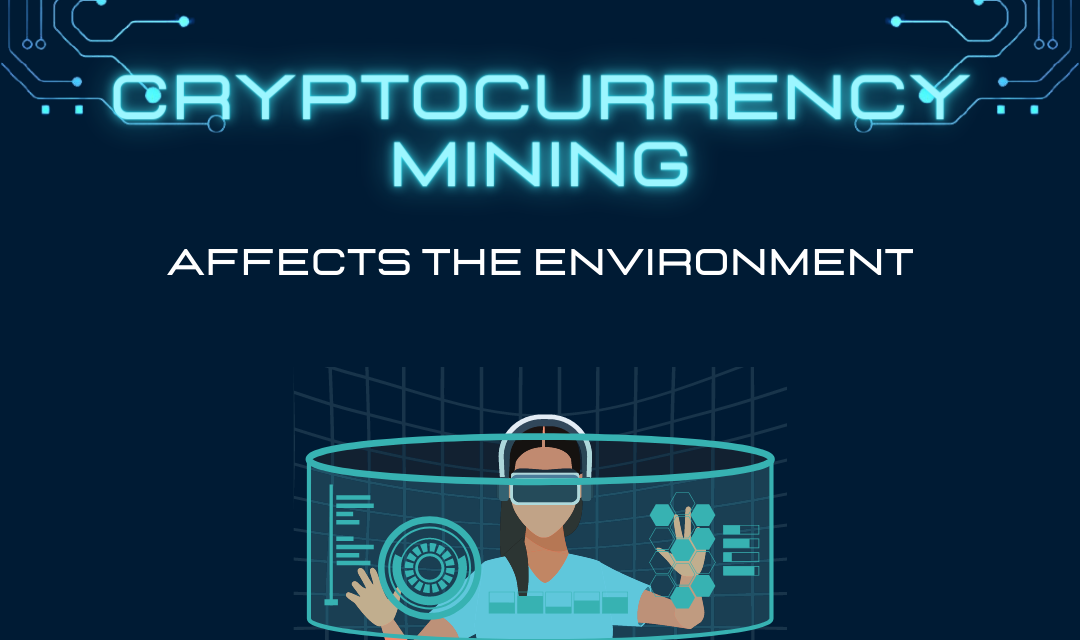In the past few years, there has been a lot of interest in mining, which is the process of verifying events and adding them to the blockchain. Even though it can be profitable for investors and hobbyists, it is bad for the earth in some ways. This piece explains what cryptocurrency mining is and how it works. It also talks about the environmental problems that come with it.
What is cryptocurrency Mining?
Cryptocurrency mining is the process of making new digital currencies and validating and recording events on a blockchain network. It includes using powerful computers to solve complicated math puzzles. This confirms and protects transactions in the blockchain.
To do the calculations needed for mining, special gear like application-specific integrated circuits (ASICs) or graphics processing units (GPUs) are used. Miners compete to figure out how to solve the puzzle, and the first one to find the right answer gets new coins.

The Effects of Mining Cryptocurrencies on the Environment
Energy Use: Mining for cryptocurrency takes a huge amount of energy. To solve hard problems, you need a lot of computing power, which means you need high-performance hardware that uses a lot of electricity. In fact, some cryptocurrencies, like Bitcoin, use a consensus method called Proof of Work (PoW), which makes the problem of using too much energy even worse. Mining needs a lot of energy, which increases the demand for fossil fuels and makes a big contribution to carbon emissions.
Carbon Footprint: The amount of carbon dioxide that comes from mining Bitcoin is a big worry. A lot of the energy used in mining comes from non-renewable sources, like coal-fired power plants. This dependence on fossil fuels adds to the amount of greenhouse gases that are released into the air, which makes climate change and environmental damage worse.
E-waste is made when mining equipment gets old or less useful over time. To stay competitive, miners keep upgrading their equipment. This causes electronic trash (e-waste) to be made when old mining rigs are thrown away. E-waste is a big problem for the environment because it includes toxic materials that can get into the soil and water and harm them.
Mining has become more centralised because it is so competitive and because hardware and power are so expensive. Large mines, which are usually clustered in areas with low energy costs, take up most of the mining environment. This makes it harder for cryptocurrencies to be decentralised, which raises worries about possible manipulation and control over the network.
Taking care of environmental worries
Change to Other Consensus Algorithms:
Some cryptocurrencies are looking into other consensus algorithms to reduce the damage mining does to the earth. Proof of Stake (PoS), for example, requires users to hold a certain number of coins to verify transactions. This takes away the need for energy-intensive calculations. This change can cut down on energy use and carbon pollution by a lot.
Integration of Renewable Energy:
Mining companies can leave less of a carbon footprint if they use more renewable energy sources, such as solar or wind power. Some mining farms have already switched to using green energy, but more farms need to do this for it to have a big impact on the environment.
Recycling and Proper Disposal:
Miners and makers should put recycling and proper disposal of old mining equipment at the top of their to-do lists to help solve the e-waste problem. E-waste can have less of an effect on the environment if proper recycling programmes are put in place and old equipment is rewarded for being returned.
Education and Awareness:
It is very important to teach people about how mining cryptocurrency affects the earth. Educating miners and the general public about how important it is to use energy-efficient mining methods and handle e-waste in a responsible way can lead to positive changes in the industry.
Conclusion
Mining for cryptocurrency has changed the way money is made and spent, but it also has a big effect on the environment that can’t be ignored. High energy use, carbon emissions, the creation of e-waste, and the centralization of mining are important issues that need to be looked at. By looking into different consensus methods, using renewable energy, and
By continuing to use ChatGPT sources, encouraging responsible disposal and recycling, and educating and raising knowledge, the negative effects of cryptocurrency mining on the environment can be lessened.
Switching to different consensus methods, like Proof of Stake (PoS), could help reduce the amount of energy used to mine cryptocurrencies. PoS requires users to hold a certain number of coins to verify transactions.
This means that users don’t have to do calculations that use a lot of energy. By making it easier for people to use PoS or similar algorithms, cryptocurrencies can reduce their carbon output by a lot.
Using renewable energy sources in mining is another important step towards reducing the damage to the earth. Investing in solar, wind, or hydroelectric power can provide sustainable energy for mining activities, reducing the need for fossil fuels and lowering carbon pollution. The cryptocurrency business should support and reward projects that encourage the use of renewable energy.
Taking care of the problem of e-waste is just as important. Miners and makers should be responsible for getting rid of and recycling old mining equipment in the right way.
Toxic materials can’t get into the environment if there are recycling programmes and rules in place to make sure that e-waste is handled safely. By giving rewards for recovering old mining equipment, you can also get people to take better care of their e-waste.
Education and awareness are very important for making the cryptocurrency mining business better. Miners and users should know what effects their actions have on the world and be encouraged to change their ways. Industry groups, governments, and environmental groups can work together to create educational programmes, workshops, and guidelines that encourage energy-efficient mining, responsible e-waste disposal, and the use of renewable energy sources.
Also, policymakers and regulators can do a lot to reduce the damage that cryptocurrency mining does to the earth. They can put in place tougher rules about how much energy is used and how much carbon is released into the air.
They can also encourage the use of renewable energy sources and set up rules for the proper disposal of electronic waste. By making regulations that are helpful, governments can push businesses to do things that are good for the environment.
In conclusion, mining cryptocurrency has changed the way digital money works, but its effects on the world can’t be ignored. High energy use, carbon pollution, the creation of e-waste, and the centralization of mining are all big problems.
But the bad effects of cryptocurrency mining can be lessened by using different consensus algorithms, using renewable energy sources, managing e-waste in a responsible way, and educating and raising knowledge about the issue. By pushing for sustainability in the business, we can try to make the future of cryptocurrencies greener and more stable.





